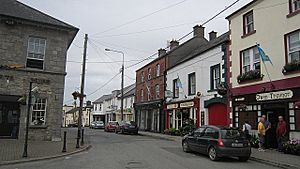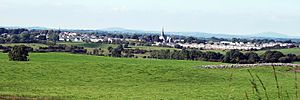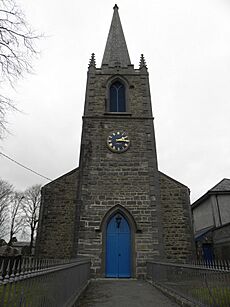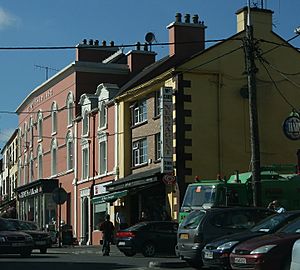Oldcastle, County Meath facts for kids
Quick facts for kids
Oldcastle
Irish: An Seanchaisleán
|
|
|---|---|
|
Town
|
|

Businesses on the Square in Oldcastle
|
|
| Country | Ireland |
| Province | Leinster |
| County | County Meath |
| Elevation | 200 ft (61 m) |
| Population
(2022)
|
1,409 |
| Time zone | UTC+0 (WET) |
| • Summer (DST) | UTC-1 (IST (WEST)) |
| Irish Grid Reference | N550803 |
Oldcastle (Irish: An Seanchaisleán) is a town in County Meath, Ireland. It is in the northwest part of the county, close to the border with Cavan. The town is about 13 miles (21 km) from Kells. Two main roads, the R154 and R195, meet in the town's market square.
In 2022, Oldcastle had a population of 1,409 people. This shows a big increase of over 70% since 1996, when the population was 826.
Contents
History of Oldcastle
Oldcastle has a rich history with many interesting events and people.
Important People from Oldcastle
The area around Oldcastle was the birthplace of St Oliver Plunkett. He was an important religious leader in the 1600s. He served as the Lord Archbishop of Armagh. Sadly, he died in London in 1681 because of false accusations. He is known as the last Irish Catholic martyr to die in England.
Another notable person was Isaac Jackson. He was an early member of the Quakers in Ireland. Quakers are a religious group known for their peaceful beliefs. Isaac later moved to Chester County, Pennsylvania, in the USA in 1725 with his family.
Oldcastle and the Great Famine
Oldcastle was greatly affected by the Great Famine in the 1840s. Many people suffered from starvation and had to leave Ireland. The northern part of County Meath, where Oldcastle is, kept more of its traditional Irish way of life. This area was hit harder than the richer farming lands in the south. Even today, the way land is used shows strong links to the old Gaelic farming culture.
Culture and Politics
The Oldcastle area has a strong tradition of supporting Irish culture and independence. Groups like the Gaelic Athletic Association (GAA) and Comhaltas Ceoltóirí Éireann are very popular here. The GAA promotes Irish sports like Gaelic football. Comhaltas Ceoltóirí Éireann focuses on traditional Irish music. A local newspaper from Oldcastle in the early 1900s even gave its name to an Irish political party, Sinn Féin.
Oldcastle Workhouse and Its Uses
The Oldcastle Workhouse was a large building designed to help the poor. It was built in the late 1830s or early 1840s. It was located on St. Oliver Plunkett Street. The workhouse was torn down before the 1950s. Today, Mellow's Park stands on its site.
During the First World War, the British Government used the old workhouse for a different purpose. They held many Germans, Austrians, and Hungarians there. These people were kept in the workhouse as a detention camp.
Mythology of Fennor
The areas of Fennor Upper and Lower in Oldcastle are said to be named after Findabair (Fennor). She was the daughter of Queen Medb from Irish Mythology. Legend says she was killed by the hero Cú Chulainn. The area was named after the place where she died and was buried.
War of Independence Monument
In 1961, a monument was put up in Oldcastle Square. It honors Commandant Seamus Coogan and Commandant Patrick McDonnell. They were killed by British forces during the Irish War of Independence. The monument is a cross and reminds people of their sacrifice.
Oldcastle Detention Camp (1916–1918)
During the First World War, Ireland was part of the United Kingdom of Great Britain and Ireland. In 1914, a law called the Alien Restriction Act was passed. This law controlled foreign nationals. It allowed the government to hold German and Austrian men of military age.
The Oldcastle workhouse became the only permanent civilian prisoner-of-war camp in Ireland. The British feared these men might join the German Army or become spies. Workhouses were perfect for this because they were large and easy to defend.
The Oldcastle Workhouse opened in 1842 and could hold 600 people. By 1914, only 50 people lived there. These residents were moved, and the building was converted. The eight-foot walls were made stronger, and barbed wire was added.
On December 12, 1914, the first German prisoners arrived. They were marched through the town to the workhouse. By February 1915, there were 304 inmates. This number grew to 579 by June 1916. Up to thirty men lived in each room. They slept on plank beds with straw mattresses.
The prisoners came from many different backgrounds. They included clergymen, musicians, cooks, and doctors. Wealthier prisoners could even buy their own rooms. They could write two letters a week and receive parcels. Visitors were allowed for 15 minutes twice a month. Aloys Fleischmann, a musician, was held there. He wrote to his wife asking for blankets and other items, showing the basic conditions.
A journalist visited the camp in 1915. He said the men seemed bored. By July 1916, the prisoners formed committees to run the camp. They managed their own washing, water, and cooking. Bakers and cooks among them prepared all the meals. The men also practiced their trades, making toys, jewelry, and wood carvings. The camp even had two orchestras that performed concerts.
One big problem for the prisoners was being separated from their families. This led to many difficulties. There were also escape attempts. Carl Morlang and Aphonsus Grein escaped for a few days. They were caught and returned to the camp.
Sadly, two inmates died at Oldcastle. August Bockmeyer was shot during an escape attempt in 1917 and later died from his injuries. Franz Xaver Seemeier died in 1917. Official reports said he died from a football injury. However, some accounts from prisoners suggested he was injured by a guard.
After the Easter Rising in 1916, feelings against British rule grew stronger in Ireland. In April 1918, a large anti-conscription meeting was held in Oldcastle. Thousands of people attended, and the speeches were very nationalistic. Prisoners watched from the roof of the camp. After this, the British decided to move the prisoners. On May 25, 1918, they were sent to Knockaloe Camp on the Isle of Man.
The Oldcastle Workhouse was returned to its owners. In May 1920, during the Irish War of Independence, the local IRA set it on fire. They did this to stop the British from using it as a military base. Today, only the perimeter wall remains.
Fun and Entertainment
Oldcastle hosts several exciting events each year.
Oldcastle Agricultural Show
The Oldcastle Agricultural Show takes place every third Sunday in July. It is held in the Gilson National Park. Thousands of people come to enjoy live music, fashion shows, and children's entertainment.
Le Chéile Arts & Music Festival
The Le Chéile Arts & Music Festival happens on the August bank holiday weekend. It has been running since 1998. Famous bands like Aslan and The Saw Doctors have performed here. Local singer Father Ray Kelly also performs in his church during the festival.
Sports in Oldcastle
Oldcastle is a great place for sports and outdoor activities.
Fishing
The town is perfect for anglers (people who fish). It is only four miles (6.4 km) from Lough Ramor in County Cavan. This lake is famous for its coarse fishing. Oldcastle is also six miles (10 km) from Lough Sheelin, which is known for its trout fishing.
Gaelic Games
The Oldcastle GAA club is over 125 years old. GAA stands for Gaelic Athletic Association. The club plays in the Meath Intermediate Football Championship.
Other Sports
Oldcastle has many other sports clubs. Saint Brigid's Athletic club has track and mountain running teams. They train near Mullaghmeen forest. Members have competed in international races, representing their club and country.
Economy and Tourism
Oldcastle is a hub for shops and services in the area. It also has several businesses that make furniture and do engineering work.
Local Industries
The town is known for its bed-making companies, such as Gleneagle Woodcrafts, Briody Bedding, and Respa Bedding. These businesses provide many jobs for people in the area. Engineering firms are also located nearby. These industries have attracted people from other countries, like Lithuania and Poland, to work in Oldcastle.
Tourist Attractions
Oldcastle is close to the Loughcrew Cairns. These are ancient passage tombs built around 3300 BCE. They are a popular tourist attraction.

Local Environment
Oldcastle is located at the base of Sliabh na Caillaigh, a local hill.
In 2005, there was an environmental issue in Oldcastle. A sewage treatment plant overflowed into the River Inny. This caused the death of 4,000 wild brown trout.
Education in Oldcastle
Oldcastle has good schools for children of all ages.
There is a primary school called Gilson National School. For older students, there is St. Oliver Post Primary, a secondary school. This secondary school has grown a lot. A new building opened in 2002, and four new classrooms were added in 2009. In 2007, the school's Gaelic football team won the All-Ireland Vocational Schools Championship Senior Cup 'B' Competition.
A new community library recently opened in the town. It is much larger than the old one and is next to the local Credit Union.
Architecture and Buildings
Oldcastle has some interesting buildings.
The Gilson National School is considered a beautiful building. It was built thanks to the kindness of Laurence Gilson, who was from Oldcastle. In 1810, Gilson gave money to the town to create a school for children of all faiths. A statue of Gilson was put up in May 2011.
The Show Hall in Oldcastle is near the church. It hosts events like bingo games, dances, and concerts during the Le Chéile festival.
Getting Around Oldcastle
Oldcastle has various transport options.
Rail Transport
Oldcastle used to have a railway station. It opened on March 17, 1863. The railway helped local farmers and businesses transport goods. The station stopped taking passengers on April 14, 1958. The entire line closed on April 1, 1963, as many railway lines were closing at that time.
Bus Services
Bus Éireann route 187 serves Oldcastle from Monday to Saturday. It connects the town to nearby places like Mountnugent, Ballyjamesduff, Virginia, and Kells. From Virginia or Kells, you can get buses to other major towns like Dublin, Cavan, Navan, and Enniskillen. The bus makes four trips to and from Oldcastle each weekday.
Famous People from Oldcastle
- Jordie Barrett (1997-), a New Zealand Rugby Union player who lived nearby for a time.
- Rory Galligan (1973–2012), a rally car driver.
- Ray Kelly, a singing priest.
- Alicia Adelaide Needham (1863–1945), a composer of songs.
- Thomas Nulty (1818–1898), a Roman Catholic bishop who supported land reform.
- Richard Ridgeway, who received the Victoria Cross medal.
International Connections
Oldcastle has a town twinning agreement with Tecumseh, Ontario, Canada. This means the two towns have a special friendship and connection.
Images for kids
-
Aloys Fleischmann, a musician, was held in the Oldcastle detention camp.
See also
 In Spanish: Oldcastle para niños
In Spanish: Oldcastle para niños





